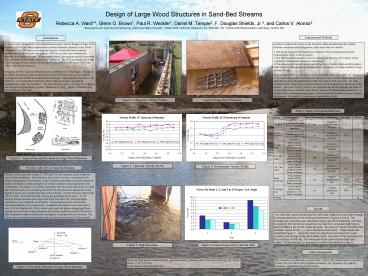Design of Large Wood Structures in SandBed Streams - PowerPoint PPT Presentation
1 / 1
Title:
Design of Large Wood Structures in SandBed Streams
Description:
Design of Large Wood Structures in ... LWS are not only more aesthetically pleasing, but are ... for sand-bed streams presents a different set of challenges. ... – PowerPoint PPT presentation
Number of Views:47
Avg rating:3.0/5.0
Title: Design of Large Wood Structures in SandBed Streams
1
Design of Large Wood Structures in Sand-Bed
Streams
- Rebecca A. Ward1, Glenn O. Brown1, Paul R.
Weckler1, Darrel M. Temple2, F. Douglas Shields,
Jr.3, and Carlos V. Alonso3 - 1Biosystems and Agricultural Engineering,
Oklahoma State University, 2USDA-ARS, Hydraulic
Research Unit, Stillwater, OK, 3USDA-ARS
Sedimentation Laboratory, Oxford, MS
Experimental Methods
Introduction
In order to solve the problem of bed and channel
erosion, various designs of large wood structures
(LWS) have been implemented in several channels,
primarily in the Pacific Northwest. The LWS
serve as an alternate solution to traditional
hard structural methods such as rip-rap, rock and
gabions. LWS are not only more aesthetically
pleasing, but are much cheaper. When properly
placed, the structure quickly traps more of the
abundant fallen timbers found in the Northwest.
The LWS are deeply keyed into cobble and gravel
beds and are also ballasted with coarse fill
(Abbe et al. 1997) that help to stabilize the
structures. Designing LWS for sand-bed streams
presents a different set of challenges. Shields
et al. (2004) described an experimental project
where LWS were placed in an unstable, incising
sand-bed channel in northwestern Mississippi.
Large members, known as key members, were
embedded in the bank while racked members, are
stacked perpendicular to the key members. The
entire structure had a yaw angle of 15 degrees
and a height of approximately 3 meters (Shields
et al. 2001). Figure 1 illustrates how these
structures were built.
- In order to examine the forces on the tie-down
cables and determine the optimal structure
orientation and configuration, three main tasks
are needed - 1. The forces acting on the structure are
measured while including buoyant and hydrodynamic
forces on the tie downs. - 2. The effects on hydrodynamic forces by rotating
the structure 180º relative to the orientation of
the standard design are determined. - 3. The influence of structural design on driving
forces, velocity field, and flow pattern in the
vicinity of the structure is determined by
varying the yaw angle, number of logs, and size
of logs. - There are three runs (1) velocity at 1.3 ft/s
and barely submerged depth, (2) velocity at 1.3
ft/s and submerged by more than two diameters,
and (3) much higher velocity and a depth that
produces the greatest forces (this was done by
trial and error). For each orientation and
configuration, the load cells provide the
magnitude of the forces on the anchors. Two main
velocity profiles (one upstream and one
downstream) are taken as eleven points across and
three points deep to examine the forces using
momentum. In addition, flow visualization using
paper confetti observes the water movement around
the structure. This series of experiments is
presented in Table 1.
Figure 3 Measuring Velocity Profiles
Figure 3 Large Wood Structure
Table 1 Matrix of Experimental Tests
Source Shields et al. (2001)
Figure 1 Typical Plan and Elevation for Large
Wood Structures
Figure 4 Upstream Velocity Profile
Figure 5 Downstream Velocity Profile
Problem with LWS in Sand-Bed Streams
Shields (2003) found after testing 72 LWS that 24
of the structures failed within two years of
their installation. Several factors were
believed to have contributed to the failures
including low wood density, scour of sediment
deposited around the structures, undersized
anchors and the assumption of critical conditions
occurring shortly after construction. The design
wood density was higher than the actual density
that occurred after several months of wood
drying therefore, the buoyant forces during the
second high flow season were greater than those
used in design. Greater buoyancy allowed the LWS
to rotate, which increased the velocity going
through the structure. As LW decayed, smaller
branches and twigs broke away from the LWS,
allowing higher velocities to occur within the
wood matrix. This increased velocity allowed the
deposited sediment to be scoured away. In
addition, the anchors were load tested to only
1,000 lb (Shields et al. 2004), which lead to
pull-out failures during high flows. Anchor size
was based on the assumption that critical
conditions would occur shortly after construction
when wood density was highest, which proved to be
incorrect. The failure rate is considered
unacceptable and provides the motivation for this
research.
Results
The initial test results proved that the LWS does
indeed slow the water enough to deposit sediment
on the eroding embankment (Figures 4 and 5). The
average flow velocities were calculated using a
grid and integrating, and then by applying the
momentum equations the maximum computed drag
force is approximately 6 lbs for the model
structure. By using 3-D vectors and the load
cell data, forces for the x, y, and z directions
were found. These results are presented Figure
7. Using the maximum drag force and applying
Froude similarity and scaling along with a safety
factor, the anchor force necessary for the
prototype is 9000 lbs. The measured forces scale
by the length ratio cubed. Further testing is in
progress to confirm the results and also to
determine which yaw angle and configuration
produces the least drag force.
Figure 7 Forces Found with Load Cell Data
Figure 6 High Flow Run
Acknowledgements
Rebecca Ward may be contacted at 111
Agricultural Hall, Oklahoma State University,
Stillwater, OK 74074Phone (918)
520-7256Email Rebecca.Ward_at_okstate.edu
This research is a collaborative project of the
USDA-ARS Sedimentation Laboratory, Oxford, MS,
the USDA-ARS Hydraulic Research Unit, Stillwater,
OK, and the Oklahoma Agricultural Experiment
Station.
Figure 2 Free-Body Diagram of Large Wood
Structure































